|
|
|
 |
Commentary, feedback or questions invited |
Fez
| We landed in Casablanca – the city where the famous film was NOT made – and saw no reason to stay in that sprawling characterless city. There is an enormous Mosque (Hassan II) which is the only Mosque open to non-Muslims, but that did not seem like enough reason to waste any of our precious days. Thus, we trained immediately to Fez. Fez el Bali (Old Fez) is basically one big medina. That is, a walled city with souq. To the naïve visitor, it seems an endless warren of streets and telephone-booth size shops, many of which have been in use, un-reconstructed for twelve hundred years. To the native resident it is of course home, dense and buzzing with life at every turning. For the medina is not just shopping; it is also home to many thousands of residents, some living in squalor and some in splendor, and it is impossible to see from the street which of those two lies behind the wall. The traditional house form of the prosperous urban Arab is the riad, a hollow square with discreet entrance, few or no windows to the street, and an inner courtyard surrounded by rooms. It can be simple or have several stories and arcades and terraces. |
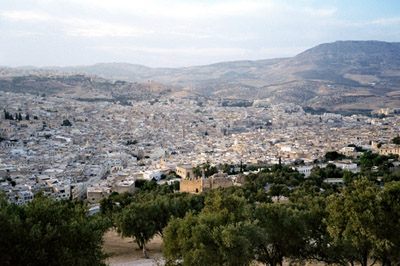
|
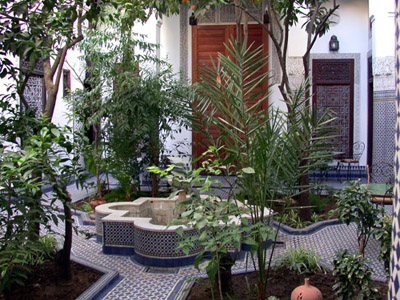
Our Riad in Fez - Riad Louna
|
The courtyard, depending on how successful a merchant you are, can range from a narrow tunnel of light to a splendid garden with trees and fountain. (The architectural form is probably more familiar in its later Europeanized form, in the splendid villas of Renaissance Italy.) We stayed in a paradisiacal riad right at the Bab Bouj-loud, the main gate to the Medina. The family and household help at the riad were primarily French-speaking, except for Abdul-Salam, who, although he insisted he never went to school a day in his life, could chat in four or five languages, all learned from talking to foreigners. An amazing, brilliant man, wasted by poverty, he ought to have been a scholar or architect. Here, he was the carpenter, electrician, errand boy
            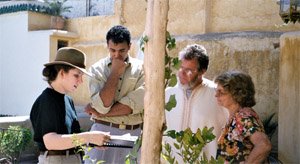
Our Hosts at Riad Louna, Jean Pierre, Jeanine and Marouan being lectured on scorpions
|
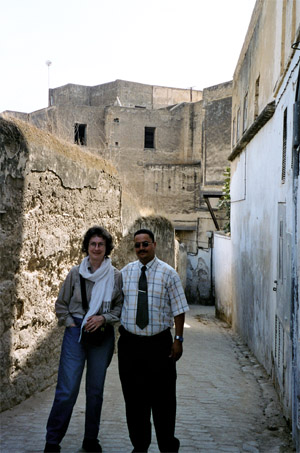
Justine and Mohammed meandering through the streets of the medina of Fez
|
We got the shopping and photographing part out of the way first. The souq (market) is labyrinthine and each district has its own craft. You cannot SEE any one place from any other; the streets are too narrow and curved. Because of this intricacy and complicated "city planning", even the most experienced traveller needs a guide to truly enjoy the experience. Official guides are available for a mere twenty dollars, and one look outside our riad convinced us, for all our bravado and knowledge of the Middle East, to hire one for the day. Thus, our guide Mohammed began with the butchers’ souq, full of squalor, squawking chickens, sheeps’ heads and dismembered livestock everywhere, and baskets and crockery of things you don’t want to know about. Surprisingly, the smell was not bad, and there were not a lot of flies. Obviously, they DID clean up the gore at the end of the day. |
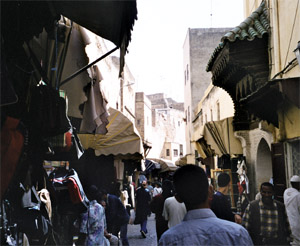
Typical "main" street in the medina of Fez
|
| Fez has a marvellous caravanserai, which it had splendidly restored and made a museum of wood carving. We were most interested in seeing first hand the three-tiered structure of the typical Caravanserai which was the desert "motel" of the Arab world, and the Silk Road for a thousand years. The ground level was for stabling the pack animals. The level above was public space where the merchants traded and the upper story was where the travellers slept. In the larger caravanserai, there would also have been a Hammam (Bath). The fountain in the picture on the left reminds us that every caravanserai was dependent on a spring, even in the middle of the desert. |
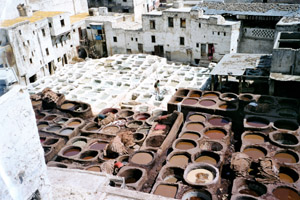
The famous Fez tannery vats
|
After the woodcarvers’ quarter and the Medrassa we saw the famous tannery. Breathtaking. No, I mean really. You couldn’t breathe except through a scarf or a fistful of mint leaves (which are given out at the door.) The centuries old curing and dye-pits below, where men worked the hides, held various pungent oils mixed with pigeon excrement (for ammonia), which wafted up into every inch of the shops on the upper stories. We bought a jacket, slippers, wallet, etc. not realizing that the smell has permeated the merchandise as well. We will have trouble wearing the jacket to work, I think.
|

Angelique and Justine at the tannery, breathtaken
|
We wandered then to the more fragrant weavers’ quarter, weapon-makers (where we bought a musket and stunning curved dagger) and tile-makers and saw everything produced by hand under desperately poor conditions. I am certain that these craftsmen would have welcomed the comfort and fresh air of Dickensian London.
|
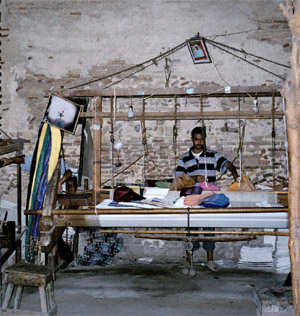
Craftsmen in the Fez medina
|
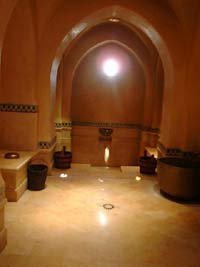
A typical luxury hamman - not ours!
|
In the evening we went to the Hammam (Baths), a local one, where there were no other foreigners, and got the whole treatment, like it or not. After payment at the door, we were met by a huge women who instructed us, largely be gesture to remove everything but panties. Ooookay. She herself, in spite of her intimidating girth, wore only the tiniest little things. She led us like two children to the third and hottest room and left us to sweat awhile. It was a high-ceiling’d chamber, with colored tile walls. At one end, two alcoves held running hot and cold water, which other women were collecting in large buckets. Bucketless, we sat waiting and watching the other women, many with children, scrubbing and chatting. A few were completely naked, but the norm was panties. Big lady came back with a sort of mitt which, without my glasses I could not make out but decided was a scrub-mitt. She pulled us both to the tile floor, took hold of my wrist and, pressing my shy little hand into her cantaloupe sized breast, she proceeded to strip several layers of perfectly good skin from my body. She scrubbed every thing, up, down, front and back, even adroitly managing to flay much of the skin from my buttocks. She was ruthless, and when she finally released me, shredded and raw, she did the same to Angelique. She left us then briefly, and we started to crawl to the door, but she headed us off and brought us back for the rest of the abuse. The massage. I know she meant well, but it was so painful that I finally slithered out from under her and curled up into a ball and said stop in all the languages I knew.
|
Angelique fared better, but we both agreed, it was a notch beyond the therapeutic, and probably did as much harm as good. As we dried, one of the other bathers who had been watching us, spoke to us in limited French and invited us to her house for tea. She indicated that she had a nice son who played lute, so we agreed. We just hoped that her son spoke better French than his mother, since her only other language seemed to be Berber. We followed her through narrow dark streets of the Medina with little clusters of swarthy men (which of course means ALL the men), feral cats and trash, and I wondered for a moment if we had just done something stupid. But her house was innocent enough, and rather pathetic. No husband in sight (we thought she might be widowed, but one does not ask) but every wall had pious religious memorabilia. Her son was not there, but we got to see him on a videotape (even poor homes have tv’s and vcr’s). He was indeed a lutist, a man who had at a very young age made the Hadj to Mecca, and it was a tape of him performing during a Ramadan concert. They were very pious Muslims, and it was all rather reminiscent of poor rural Christians in the US hinterlands, who have Jesus and nothing much else. She made us tea, and offered us bread she made herself and we of course accepted. But she was so desperate for company that she did not want us to leave. She begged us again and again to spend the night, offering to cook for us, wash, anything, just please don’t leave. After an excruciating hour of courteously listening to Arab religious music, we politely made our way free by giving her the only item I was carrying, my (fortunately unused and thus clean) new sarong. We hoped she saw it as an indication that we were not arrogant foreigners who looked down on her home.
We were a little unsure of the way back to our ryad, but found some urchins who knew the street and could lead us back. Relieved, Angelique handed them all the coins she had in her pocket. For a six year old street urchin, it was probably a fortune.
All this was on our first full day in Fez. And was just the beginning.
|
Volubilis
| One of the reasons for the trip was the scorpion search, and Angelique cleverly combined the search with a visit to the large Roman ruins near Meknes called Volubilis where the undisturbed dry ground would provide perfect conditions for a large scorpion population. |

Volubilis - The Basilica area
The Roman site is imposing, with the remains of the foundations of a whole village, forum, temple, baths, olive and grape presses, half a dozen splendid floor mosaics and an almost completely intact triumphal arch. Built for the Emperor Galen, it bears his name and face in several places. A French team was making a movie inside the temple ruins, but the heat was oppressive and I felt sorry for the actors who had to remain in elaborate costumes while they repeated their scenes over and over again. I myself was exhausted after only two hours of walking.
|
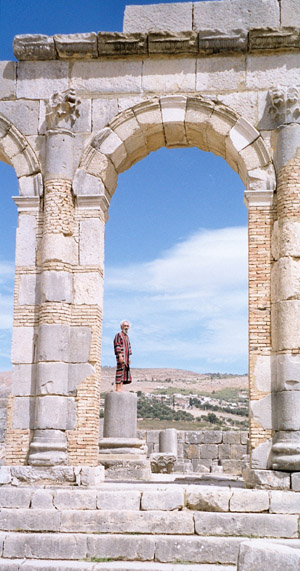
Filming in the ruins... far from "Gladiator".. this ain't Russell Crow.
|
| I allowed myself the leisure of resting serenely of the shade of the triumphal arch while Angelique went off with the Museum’s splendid digital camera for a little look-see and returned to report that there were indeed thousands of scorpion burrows and certainly large populations of the little critters deep down inside. However, the heat and light would keep them hidden until night. Even then, they would be shy, since the moon that night was three quarters and waxing. In any case, she had photographed the borrows, and we had several days to check out more deserty areas.
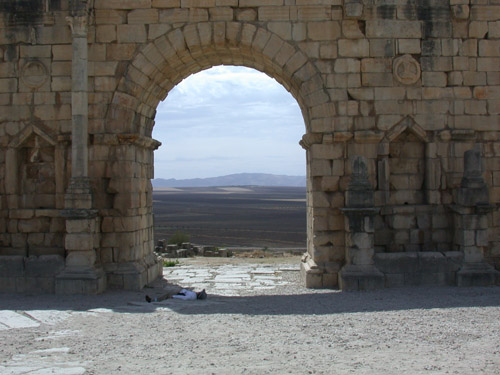
Justine allowing herself the leisure of a moment in the shade...
|
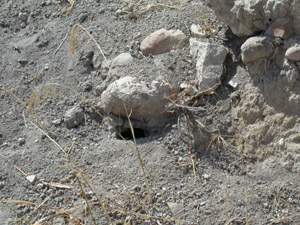
Scorpion burrow at Volubilis
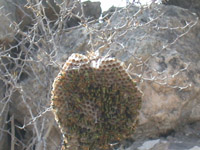
Beeware...Bee nest in construction at Volubilis

Volubilis' famous mosaic
|
Meknes
| In the late afternoon we returned to our driver (it is possible to rent a car and driver for a full day) and he took us on for a quick drive around the walled city of Meknes, since were too tired and dirty to walk around in it. Our driver Selim invited us to come and have couscous with him and his mother, but we had exactly the same problem as with the hammam lady. He spoke only Moroccan Arabic and Berber, and although Angelique can make small talk, and get us around a bit in Arabic, she (and certainly I) cannot engage in long and meaningful conversations in the Moroccan dialect. We both envisioned another evening of sign language, and eating the food of silent strangers, and begged off. Even begging off was difficult. We were not quite sure that “Thank you, we have important other business this evening” sounded very convincing, or even correct. In any case, he took no offense, and as a parting gift he gave us both an audiotape of Umme Koulsum (an Egyptian religious singer) whom we had politely admired. We had nothing to give him, but had already paid him well beyond the official price, and he seemed jolly enough as he left us off at our riad. |
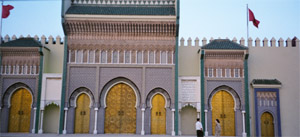
Meknes - The Royal Palace
|
Click on the links below for more adventures in Morocco
|
|
|